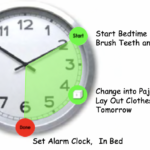Minimizing (and Surviving) the Transition Back-to-School
by Miquon Social Worker Julia Rolf
Transitions are hard for most people and can be especially difficult for children. Add in the increased anxiety and mental health problems for children and their families due to the pandemic and we have the potential for some serious morning meltdowns. Here are some ideas for managing during this time:
1) Children thrive on routine and predictability. They love to know what is about to happen. It can increase a sense of control in a world that often feels very out of control. Think about having a “morning message” like we do at school. It could be on a whiteboard in the kitchen and include info like who is doing drop off and pick up and any after school activities or changes to the normal schedule. For younger children it could even include times for dinner and bedtime to decrease disappointment about playtime ending. Go over it before leaving the house in the morning or the night before.
2) Practice the morning routine the day before school starts. Work with your child (even kids as young as 3 can do this!) to create a morning routine that is predictable and structured. Write it down in a way they can understand (using pictures for our youngest students). Then pick a time during the day before school starts to run through it. This will help your child to know what is expected of them in the morning, and may create muscle memory for how to move through their morning towards school.
3) Use checklists, a working clock, or picture to help with executive functioning.
Make a checklist a game or laminate it (I use packing tape) so they can chec k off what they’ve done with a dry erase marker as they go (never underestimate the power of a dry erase marker to motivate a child!).
k off what they’ve done with a dry erase marker as they go (never underestimate the power of a dry erase marker to motivate a child!).
A working clock is like a checklist but turns an analog clock  into a map of your morning using a dry erase marker. This actually helps your child (and maybe even you if you are like me!) to learn how to feel the passage of time.
into a map of your morning using a dry erase marker. This actually helps your child (and maybe even you if you are like me!) to learn how to feel the passage of time.
Ta ke a photo of all of the things your child needs in their backpack. Instead of verbally reminding them to grab their water bottle 10 times, you can point to the picture and ask them to make sure they have everything. You can also take a photo of your child ready for school (great time for this is the end of the morning practice run). Instead of asking them to get their shoes on 45 times you can point to the picture and ask them what they are missing to be ready to get out of the door. Extra time to play is always the perfect reward for getting ready quickly.
ke a photo of all of the things your child needs in their backpack. Instead of verbally reminding them to grab their water bottle 10 times, you can point to the picture and ask them to make sure they have everything. You can also take a photo of your child ready for school (great time for this is the end of the morning practice run). Instead of asking them to get their shoes on 45 times you can point to the picture and ask them what they are missing to be ready to get out of the door. Extra time to play is always the perfect reward for getting ready quickly.
4) Minimize plans: fall can be a time filled with social commitments. Whenever possible, it can be really helpful to slow down during big transitions and give kids (and grownups) time to rest and recover from all the change that is taking place. Plan a family game night instead of a play date. Watch a movie together instead of separate screen time. Snuggle as much as your kid will allow. Physical touch can be incredibly soothing to an activated nervous system!
5) Prepare for and make space for the meltdowns regardless of what they are about. Change is stressful no matter how prepared you are. But often, our children will exhibit stress around completely unrelated things. So if your child has an all out tantrum about the way their carrots were cut, if you see an uptick in sibling conflict, or some other seemingly random problem, know that this is probably related to the big transition they are going through and the normal stress that often comes with transitions. Prepare mentally for some of this so that you are ready to respond with patience and can stay calm yourself.
Bonus tip: be kind to yourself during this time. The transition back to school can be hard for caregivers as well. The simple act of bringing awareness to an experience can help us to cope and make it through to the other side.